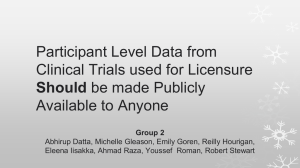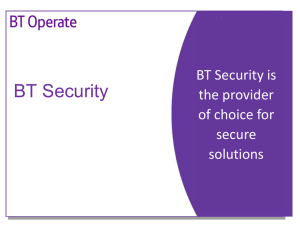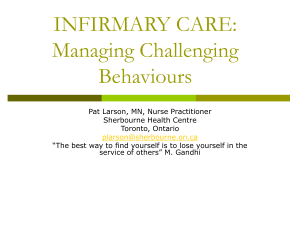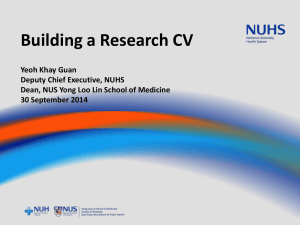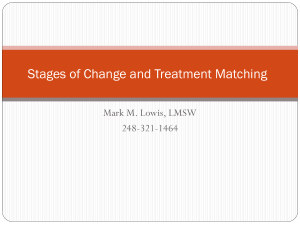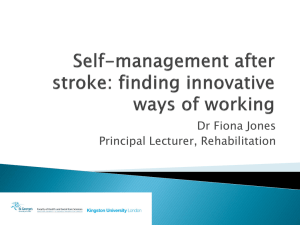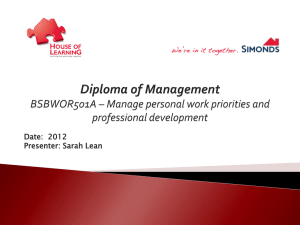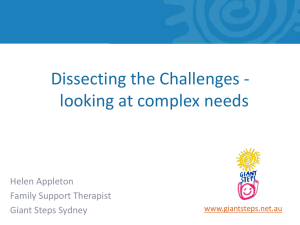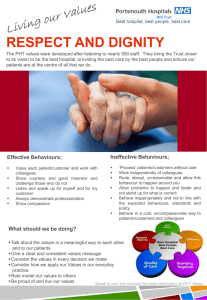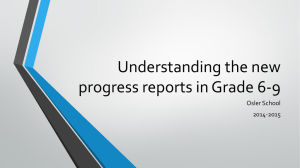The Health Foundation`s Co-Creating Health Initiative
advertisement
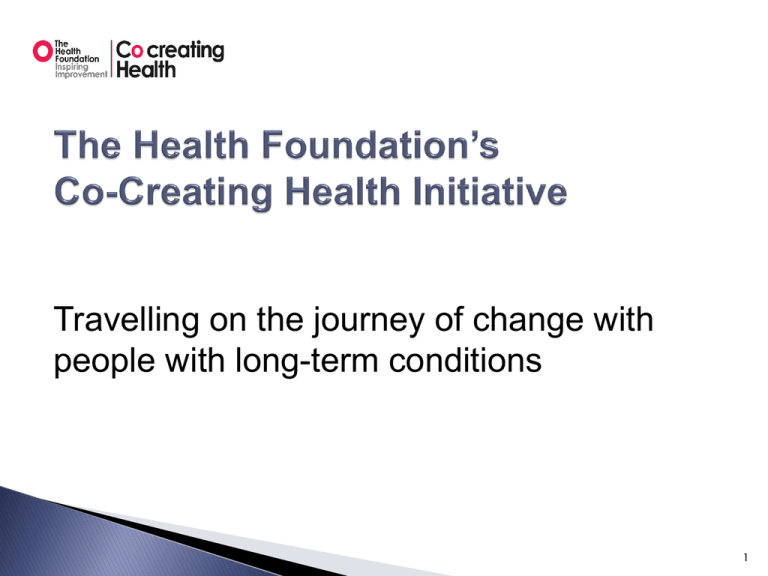
Travelling on the journey of change with people with long-term conditions 1 When people self-manage, they are more likely to: Experience better health and well-being; Reduce the perceived severity of their symptoms, including pain; Improve treatment adherence; Prevent the need for emergency health and social services input; Prevent unnecessary hospital admissions; Have better planned and co-ordinated care; Remain in their own home; Have greater confidence and a sense of control. 2 Self-Management, by definition, is led, owned and done by the people themselves. The NHS cannot do self-care to people, but what it can do is create an environment where people feel supported to self-care. This is not just about a change in service provision, but about a cultural change, allowing patients to be partners in their care, letting them decide what support they need, when they need it and how. 3 In 2008/9 in England, 49% of all inpatient bed days were occupied by just 5% of patients The treatment and care of people with Long-Term Conditions accounts for approximately 69% of the primary and acute care budget in England 4 People with LTCs are far higher users of health and social care services than average, accounting for approximately 50% of General Practice consultations, 65% of out-patient appointments and 70% of inpatient bed days. At the current rate of growth, expenditure on LTCs will increase by 94% by 2022 – whereas the NHS budget won’t Source: Improving the Health and Well-being of people with Long-Term conditions DOH 5 The biggest ‘Efficiency Frontiers’ are where the major costs in healthcare are: • Management of people with long-term medical conditions • Care of older people • Reducing avoidable emergency admissions • Care for people at the end of their lives Source: Nuffield Trust (2010): Making Progress on Efficiency in the NHS in England – Options for System Reform 6 SMP – Self-Management Programme for patients ADP – a clinician training programme based on motivational interviewing techniques SIP – service improvement programme; designed to make system changes that promote self-care 7 Self-care needs movement from both sides Move away from traditional doctor-patient relationship Meeting between two experts sharing different knowledge Better doctor-patient communication leads to better health for the patients, measured either: ◦ Physiologically e.g. blood pressure, blood sugar ◦ Behaviourally (functional status) ◦ Subjectively (beliefs about overall health status) Source: Med Care (1989): 27S110 – S127 8 Traditional vs. Collaborative Interactions Traditional Interactions Collaborative interactions Information and skills are taught based on the clinician’s agenda Patients and clinician share their agendas and collaboratively decide what information and skills are taught There is a belief that knowledge creates behaviour change There is a belief that one’s confidence in the ability to change, together with skills and knowledge, creates behaviour change The patient believes it is the clinician’s role to improve health The patient believes that they have an active role to play in changing their own behaviours to improve health Goals are set by the clinician and success is measured by compliance with them The patient is supported by the clinician in defining their won goals. Success is measured by an ability to attain those goals Decisions are made by the clinician Decisions are made a patient-clinician partnership 9 Source: University of Oregon 10 Use activation level to determine what are realistic “next steps” for individuals to take Many of the behaviours we are asking of people are only done by those in the highest levels of activation When we focus on the more complex and difficult behaviours, we discourage the least activated Start with the behaviours more feasible for patients to take on, increases individual’s opportunity to experience success Source: University of Oregon 11 Level 1 Develop basic knowledge, self-awareness and confidence Individual becomes self-aware of own behaviours and symptoms. Focus coaching on the relationship between symptoms and behaviours, building self-confidence and awareness. The individual should choose the areas they want to work on Level 2 Increase in knowledge, initial skills development Individual develops the knowledge, skills and confidence needed to master new self-management competencies. Coaching should focus on helping the individual learn to monitor symptoms, behaviour and adverse triggers – and adjust accordingly. Focus on taking small steps. Level 3 Initiate new behaviours Individuals initiate new health promoting behaviours and work to further refine techniques to monitor and adjust. Coaching should focus on providing encouragement, noticing successes and problem solving. Level 4 Maintaining behaviours and techniques to prevent relapse Individual strives to maintain desired health-related behaviours over time and learn to anticipate difficult situations that will arise. Coaching should focus on the issues that make it hard to stick to correct behaviours and to help the individual troubleshoot. Source: University of Oregon 12 Importance Confidence Use of Problem-Solving Level 1 Low Low Low Level 2 Increasing Low Low Level 3 High High for some Low Level 4 High High High 13 Clinicians can’t do it alone Patients don’t have all the knowledge and technology Clinician-patient partnership yields best health and quality of life Skills are needed to foster clinician-patient partnership 14 Agenda Setting - skills for exploring and agreeing the agenda Goal setting – skills for collaboratively planning goals and action plans with patients Follow-up – skills for arranging and discussing what action has been taken and developing collaborative problem-solving with patients 15 Inviting patients to contribute their beliefs, knowledge and values that are critical to co-creating an approach to their health and well-being 16 Clinicians and patients collaborating on the goals of treatment and action steps that each will pursue to address health and well-being 17 Patient and clinician supporting self-management by arranging to learn from the results of an action plan 18 Clinician and patient examine challenges to selfmanagement and collaboratively identify possible solutions to try out 19 20 Skills for learning the patient’s perspective The power of the patient’s perspective A strong relationship Key skills ◦ Open-ended questions ◦ Reflection ◦ Empathy 21 Open-ended questions Begin with: “How?” “Who?” “Where?” “When?” “What? “Tell me..” Avoid: “Why?” - can be risky Questions that invite many possible answers, not yes/no answers or a number 22 Words to start reflection: “So, you are saying…” “It sounds like…” “You are wondering if…” “ I hear you saying…” 23 Reflection: “You seem [frustrated, worried, sad]…” Validation: “Anyone would feel…” Partnership: “I’d like to help…” Respect: “I’m impressed by how you…” 24 Exercise: Think of a change you are considering Groups of 3 ◦ Interviewer, Observer, Interviewee Explore colleague’s thoughts on change Observer tracks open-ended questions, reflections and empathic statements Switch roles 25 26 The patient’s perspective Agenda, priorities Level of activation Importance and confidence 27 The clinician’s perspective Patient health status Take a long-term view Supporting autonomy and choice 28 “What is the goal you are working towards?” “So, what will you do this week?” “How important is it to you?” “So how much…will you do?” “When will you do it?” “How often will you do it this week?” “If you visualise yourself doing this over the week, how confident do you feel that you can achieve this?” 29 S – Specific – “So what will you do this week?” M – Measurable – How much, how often: “So how much….....will you do this week?” A – Achievable – ““If you visualise yourself doing this over the week, how confident do you feel that you can achieve this?” R – Realistic – “How confident are you?” 0 7 10 T – Time-based – “When will you do it?” 30 Consider where you are, right now, on the journey of supporting patient self-management: ◦ Write down what you have stared doing that contributes to your success ◦ Write down other skills, techniques and phrases you’d like to add to your practice In groups of 4, share your thoughts about what you have accomplished and where you would next like to go in your journey. 31 Thank you for joining us today. We hope you have given you a taste of what we have been doing with clinicians and patients to improve the lives of people with long-term conditions. If you are interested in finding out more, please contact the Self Care Team on 01803 210476 or e-mail selfcare.tct@nhs.net 32

